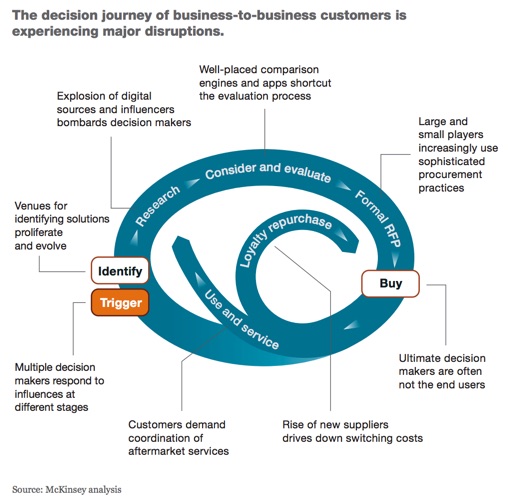That journey, of course, is rarely linear – and you can’t expect every member of the decision-making team to be at the same stage in his or her personal journey. The project as a whole, and the support of individual stakeholders, may move forward, stall, go backwards or be abandoned completely.
Now this is a complex thing to model (and a tough concept for some middle-of-the road sales people to grasp), but that’s no reason to go into denial. Defining your pipeline in terms of buying decision stages, basing your milestones on observed advances in buying behaviour, and working hard to not just identify, but also identify with the key stakeholders are key strategies to cope with the new B2B buying landscape.
Segment according to customer behaviour
The next thing you need to do is to abandon the idea that demographics are anything more than table stakes when it comes to market segmentation. McKinsey’s research and our own experience clearly proves that it is much more useful to segment customers along structural, situational and – most importantly – behavioural dimensions.
By behaviour, I mean how they are likely to buy, what considerations are likely to be most important in shaping their buying decision, the way in which they might prefer to consume information, and how they prefer to interact with potential vendors.
There’s no point in ignoring these considerations, or stumbling across them too late in the decision making process to have any impact. Early on, through a variety of mechanisms, you’ve got to assess what type of customer you’re dealing with, whether you choose to pursue them, how you can best support their decision making process, and how you can position yourselves to win.
Organise to optimise the customer experience
For the customer-behaviour-based segments you choose to pursue (and you probably won’t and shouldn’t choose to pursue them all with equal vigour), you’ve got to organise internally in a way that ensures that you optimise the customer experience.
It’s essential, in our experience, to align both sales and marketing around the key phases in the customer’s buying journey. What information are they likely to require? How might they prefer to consume it? How can you best facilitate their progress at each stage? If early interaction is a key success factor (it almost invariably is), how can you encourage it, and how can you ensure that each interaction generates real value for the customer?
Of course, this isn’t and mustn’t be a one-way street. What information do you need to know about the prospect, and how can you gather that information most effectively? How can you most effectively build up a picture of the buying dynamics within the organisation? If sales and marketing aren’t working together towards this common purpose, you are making the task of qualifying and winning opportunities that much harder.
Really know your customers
Customer knowledge is perhaps the critical factor. Firstly, you need to understand your markets, and how they behave. But once the interaction starts, you need to understand what really matters to each particular customer – and each individual stakeholder. It requires a combination of macro-and micro-research. And it’s another very good reason why you need to start by aligning your sales and marketing efforts at every level with your customer’s buying decision process.




